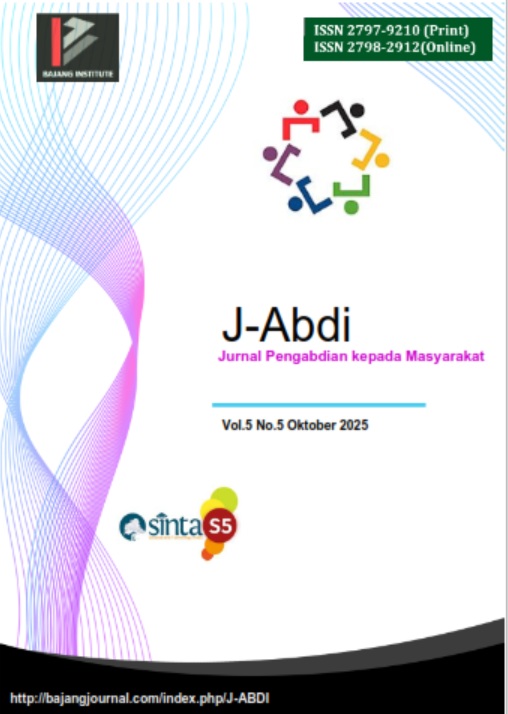PEMERIKSAAN HIPERTENSI PADA LANSIA DI KOMUNITAS YOGA DHSP BALI, BANJAR SINGIN, SELEMADEG, KABUPATEN TABANAN
DOI:
https://doi.org/10.53625/jabdi.v5i5.11397Keywords:
Hypertension, elderly, DHSP Bali Yoga communityAbstract
Hypertension is one of the most common health problems in the elderly and is the main risk factor for cardiovascular disease, stroke, and kidney failure. This examination aims to detect hypertension in the elderly community at DHSP Bali. The results of blood pressure screening showed that almost half of the participants in the DHSP Bali community were prone to hypertension, namely 15 people (46,87%). Adequate therapy handling, periodic monitoring and prevention education are needed to be able to reduce the number of complications due to hypertension in the elderly group.
References
Kementerian Kesehatan Republik Indonesia. Derajat Kesehatan 40% Dipengaruhi Lingkungan. Jakarta: Kemenkes RI; 2019. Tersedia dari: https://kemkes.go.id/eng/derajat-kesehatan-40-dipengaruhi-lingkungan
Hariyanto T, Putri ND, Rahmawati I. Faktor risiko penyakit tidak menular di Indonesia: Tinjauan literatur. J Kesehatan Masyarakat. 2020;16(3):450–458.
World Health Organization. Noncommunicable diseases. Geneva: WHO; 2023 [diakses 2025 Sep 22]. Tersedia dari: https://www.who.int/news-room/fact-sheets/detail/noncommunicable-diseases
World Health Organization. Hypertension fact sheet. Geneva: WHO; 2023 [diakses 2025 Sep 22]. Tersedia dari: https://www.who.int/news-room/fact-sheets/detail/hypertension
Kementerian Kesehatan Republik Indonesia. Hasil Riset Kesehatan Dasar (Riskesdas) 2018. Jakarta: Badan Penelitian dan Pengembangan Kesehatan; 2018. Tersedia dari: https://www.kemkes.go.id/resources/download/info-terkini/hasil-riskesdas-2018.pdf
Kementerian Kesehatan Republik Indonesia. Potret Kesehatan Indonesia dari Riskesdas 2018. Jakarta: Kemenkes RI; 2019. Tersedia dari: https://www.kemkes.go.id/id/rilis-kesehatan/potret-sehat-indonesia-riskesdas-2018/
Mills KT, et al. Global Disparities of Hypertension Prevalence and Control: A Systematic Analysis. Circulation. 2020;141:1400-1416.
Zhou B, et al. Worldwide trends in hypertension prevalence 1990–2019. Lancet. 2021;398:957-980.
WHO. Hypertension fact sheet. Geneva: World Health Organization; 2021.
NCD-RisC. Worldwide trends in blood pressure from 1975 to 2021. Lancet. 2022;400:1831-1846.
Kemenkes RI. Riskesdas 2023: Laporan Nasional. Jakarta: Balitbangkes; 2023.
Pinto E. Blood pressure and ageing. Postgrad Med J. 2020;86:109-114.
WHO. Guideline for the pharmacological treatment of hypertension. Geneva: WHO; 2021.
Unger T, et al. 2020 ISH Global Hypertension Practice Guidelines. Hypertension. 2020;75:1334-1357.
James PA, et al. 2014 JNC 8 Guidelines. JAMA. 2014;311(5):507-520 (Reaffirmed 2020).
Safar ME, et al. Arterial stiffness and hypertension. J Hypertens. 2021;39:421-431.
Iadecola C, et al. Hypertension and brain damage. Hypertension. 2020;75:895-904.
Qiu C, et al. Hypertension and dementia risk. J Alzheimers Dis. 2021;82:153-165.
Whelton PK, et al. 2018 ACC/AHA Guideline (Reaffirmed 2022). J Am Coll Cardiol. 2018;71:e127-e248.
Appel LJ, et al. Lifestyle modification and blood pressure. N Engl J Med. 2021;384:216-224.
Burnier M. Drug adherence in hypertension. Pharmacol Res. 2020;153:104634.















